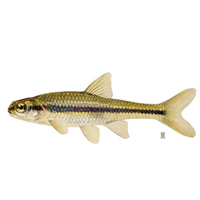Bridle shiner
Scientific name: Notropis bifrenatus

Cover photo credit: New York State Department of Environmental Conservation
Status
Special Concern
“Special Concern” means the species lives in the wild in Ontario, is not endangered or threatened, but may become threatened or endangered due to a combination of biological characteristics and identified threats.
Date added to the Species at Risk in Ontario List
The Bridle Shiner was already assessed as a species of special concern when the Endangered Species Act took effect in 2008. It was re-assessed as special concern in 2013.
Read the report (PDF)
What it looks like
The Bridle Shiner is a small minnow with a slender body growing up to six centimetres in length. It has a small mouth which extends back to the lower edge of the eye.
Adult Bridle Shiners are generally silvery, often with a green-blue iridescence. The surface of the body is straw-coloured while the underside is silvery-white. Bridle Shiners also have a dark stripe that extends along the side of the body, but at times may be quite faint and difficult to see.
The Bridle Shiner spawns in the spring and early summer. During this period the fins on both sexes become pale yellow, while the sides of the males turn a yellow or gold and the front of their pectoral fins become darker.
Bridle Shiners live for two years and usually only spawn once.
Where it lives
Bridle Shiners prefer clear, unpolluted streams, rivers and lakes which have an abundance of aquatic vegetation. These vegetated areas provide suitable spawning habitat and places to feed and hide from predators. Bridle Shiners prefer warm water habitats where the bottom is either sand, silt or organic debris, which is necessary for the establishment of aquatic vegetation.
Where it’s been found in Ontario
The Bridle Shiner is found in eastern North America, extending from eastern Ontario east to Maine and south to South Carolina. In Ontario, it has been identified at 17 sites in the eastern Lake Ontario drainage and the St. Lawrence River.
What threatens it
Bridle Shiners are sensitive to sediment and chemical runoff into the water from agricultural lands, and the resulting decrease in water clarity and quality.
One invasive species, Zebra Mussels, may have helped local populations by improving water clarity. Another invasive species, Eurasian Watermilfoil, clogs shallow spawning areas for the minnow and may be contributing to declines.
Action we are taking
Special concern species do not receive species or habitat protection.
What you can do
Report a sighting
- Report a sighting of an endangered animal or plant to the Natural Heritage Information Centre. Photographs with specific locations or mapping coordinates are always helpful.
Volunteer
- Volunteer with your local nature club or provincial park to participate in surveys or stewardship work focused on species at risk.
Be a good steward
- Private land owners have a very important role to play in species recovery. You may be eligible for stewardship programs that support the protection and recovery of species at risk and their habitats.
- Land owners can help improve fish habitat and keep Ontario’s water safe and clean by maintaining natural vegetation next to creeks and rivers, and keeping pollution and soil from washing into Ontario’s rivers. You can find more information about programs and funding assistance for eligible farmers from the Ontario Soil and Crop Improvement Association website at www.ontariosoilcrop.org/en/programs/species_at_risk.htm.
Report illegal activity
- Report any illegal activity related to plants and wildlife to
1-877-TIP-SMNR (847-7667) .
Quick facts
- The Bridle Shiner can be easily confused with the Blacknose Shiner, Blackchin Shiner and the Pugnose Shiner with which it commonly shares clear vegetated habitats.
- As with minnows in general, Bridle Shiners are often prey for larger species of fish such as members of the pike, bass and perch families.
- Blackstripe Topminnows are only found in a very small area of Ontario and may have one of the smallest distributions of any fish in Canada.